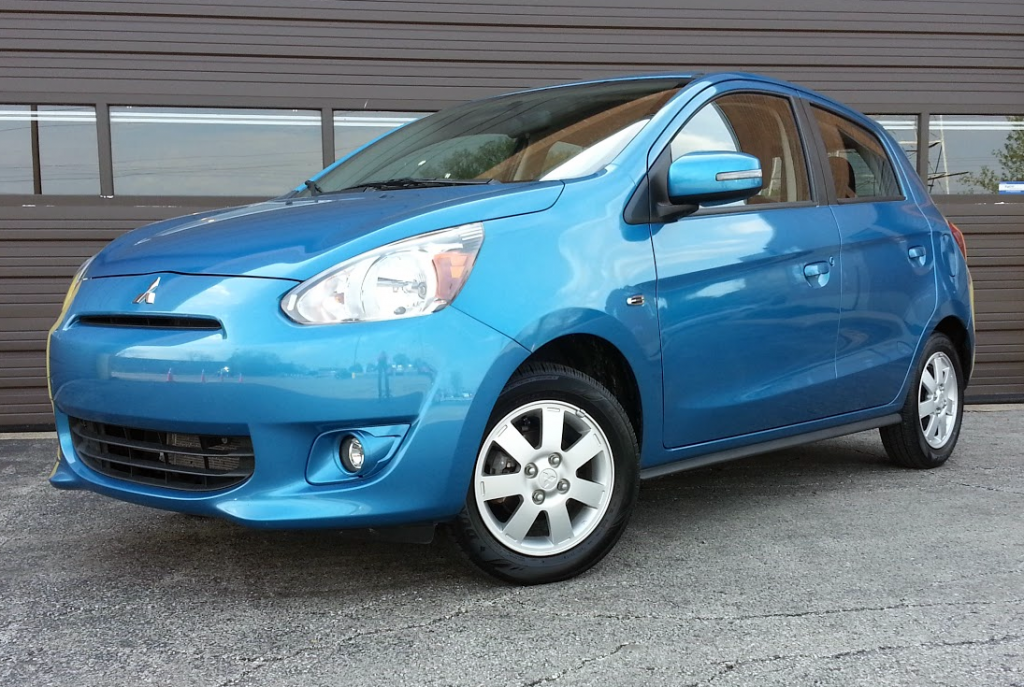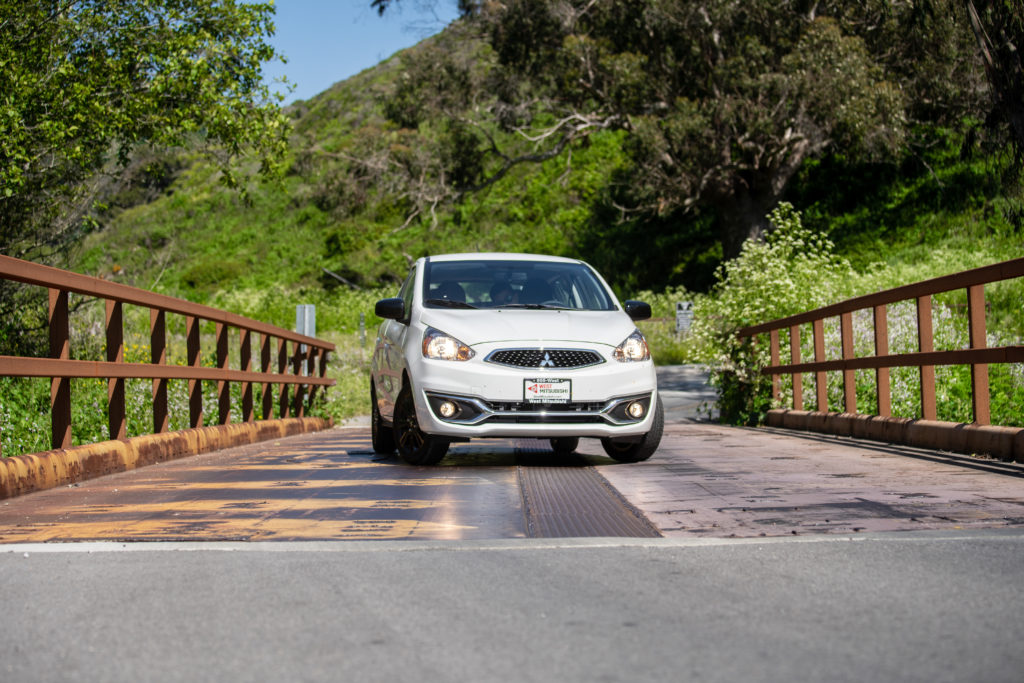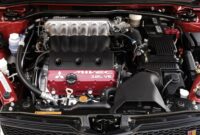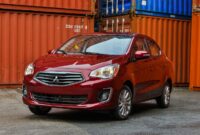Mitsubishi Mirage fuel efficiency real world tests: Unveiling the truth behind the MPG claims! Is the Mirage truly as fuel-efficient as advertised? We dive deep into real-world driving data, exploring various factors that impact fuel consumption, from aggressive driving styles to regular maintenance. Get ready to separate fact from fiction and discover how the Mirage performs on the open road.
This exploration goes beyond manufacturer specs, analyzing data from owner surveys, professional tests, and independent reviews. We’ll examine how different Mirage models and model years stack up against each other, revealing potential variations in fuel economy. Prepare to learn how driving habits, weather conditions, and even tire pressure can significantly impact your gas mileage. We’ll also compare real-world findings to official EPA estimates, highlighting any discrepancies and explaining potential reasons for the differences.
Mitsubishi Mirage Fuel Efficiency

The Mitsubishi Mirage has carved a niche for itself as a champion of fuel efficiency. Its reputation precedes it, often cited as a top contender among economical city cars. This impressive fuel economy isn’t just a matter of luck; it’s the result of a carefully considered design and engineering approach focusing on lightweight materials and aerodynamic optimization. Understanding the nuances of the Mirage’s fuel efficiency requires exploring its design features and the variations between different models.The Mirage’s lightweight construction plays a significant role in its fuel-sipping capabilities.
Utilizing high-strength steel and strategically minimizing overall weight reduces the engine’s workload, leading to less fuel consumption. Furthermore, its aerodynamic design, featuring a sleek profile and carefully engineered underbody, minimizes wind resistance, another major factor impacting fuel economy. These design choices work in tandem to maximize the efficiency of the engine, translating to impressive real-world fuel consumption figures.
Mirage Model Variations and Fuel Consumption
Different Mirage models and trim levels can exhibit slight variations in fuel economy. Factors such as engine size, transmission type (manual or automatic), and optional features (like larger wheels) can influence the overall fuel efficiency. While the base model typically boasts the highest MPG, higher trim levels might offer slightly lower fuel economy due to added weight or features.
For example, a Mirage equipped with larger alloy wheels might experience slightly reduced fuel efficiency compared to a model with standard steel wheels, due to increased rolling resistance. It’s crucial to consult the official fuel economy ratings provided by Mitsubishi for the specific model and year to get the most accurate information. These figures, usually expressed in miles per gallon (MPG) or liters per 100 kilometers (L/100km), provide a standardized comparison between different models and manufacturers.
Remember that real-world fuel economy can vary based on driving habits, road conditions, and climate.
Gathering Real-World Data on Fuel Efficiency: Mitsubishi Mirage Fuel Efficiency Real World Tests

Accurately assessing the real-world fuel efficiency of a Mitsubishi Mirage requires a multifaceted approach, going beyond the manufacturer’s claimed figures. Understanding how various driving conditions and methodologies influence fuel consumption is crucial for a comprehensive evaluation. This involves collecting data from diverse sources and analyzing the results to get a clear picture of the Mirage’s performance in everyday use.Real-world fuel economy data for the Mitsubishi Mirage can be gathered through several methods, each with its strengths and weaknesses.
These methods encompass a range of approaches, from leveraging owner experiences to employing professional testing procedures. The data collected will reflect the impact of driving style, road conditions, and environmental factors on the vehicle’s fuel consumption. Careful consideration of these factors is vital for drawing accurate conclusions.
Data Collection Methods Comparison
The following table compares different methods for collecting real-world fuel economy data for the Mitsubishi Mirage, highlighting their advantages and limitations. The choice of method significantly influences the scope, accuracy, and reliability of the resulting data.
| Method | Advantages | Disadvantages | Example Source |
|---|---|---|---|
| Owner Surveys | Large sample size potential, reflects diverse driving habits and conditions. | Data accuracy relies on owner honesty and consistent reporting; potential for bias. | Online forums dedicated to Mitsubishi Mirage owners; social media groups. |
| Professional Testing (e.g., EPA, independent automotive publications) | Standardized testing procedures ensure consistency and comparability; high accuracy. | Limited representation of diverse real-world driving scenarios; cost-intensive. | EPA fuel economy website; reports from magazines like Consumer Reports or Edmunds. |
| Independent Reviews (e.g., YouTube channels, automotive blogs) | Provides a variety of perspectives and driving styles; can include detailed descriptions of testing methodologies. | Varying levels of testing rigor and consistency; potential for bias or sponsorship influence. | Popular automotive YouTube channels conducting fuel economy tests; independent automotive blogs with detailed reviews. |
Reliable Sources for Real-World Fuel Efficiency Information
Several reliable sources provide real-world fuel efficiency information. These sources often utilize different methodologies and may present slightly varying results, emphasizing the importance of considering multiple perspectives. The consistency across sources, however, can offer a more accurate overall picture.For instance, the Environmental Protection Agency (EPA) website offers standardized fuel economy ratings, although these are based on controlled testing and may not perfectly reflect real-world driving.
Independent automotive publications and websites like Consumer Reports and Edmunds conduct their own testing and analysis, often incorporating owner feedback. Finally, numerous automotive YouTube channels and blogs offer real-world fuel economy tests, though the quality and rigor of these tests can vary significantly. Careful evaluation of the methodology used is therefore crucial.
Factors Influencing Real-World Fuel Efficiency
The manufacturer’s estimated fuel economy for the Mitsubishi Mirage, while a useful benchmark, often differs from real-world results. Numerous factors beyond the control of the manufacturer significantly impact fuel consumption. Understanding these factors allows drivers to optimize their fuel efficiency and potentially save money on gas. This section will delve into some key elements influencing real-world fuel economy.
Real-world tests show the Mitsubishi Mirage consistently delivers impressive fuel efficiency. This focus on economy contrasts sharply with the rugged power needed for off-road adventures, a realm where the Mitsubishi Triton truly shines; check out this detailed comparison Mitsubishi Triton off-road capability comparison with competitors to see how it stacks up against the competition. Returning to the Mirage, its fuel efficiency remains a key selling point for budget-conscious drivers.
Several variables contribute to the disparity between advertised and actual fuel efficiency. These range from driving habits and vehicle maintenance to environmental conditions and even the weight carried by the car. By considering these factors, drivers can gain a more realistic understanding of their Mirage’s fuel consumption and make informed decisions to improve it.
Driving Style’s Influence on Fuel Consumption
Aggressive driving significantly reduces fuel efficiency. Hard acceleration, rapid braking, and high speeds all demand more energy from the engine, resulting in increased fuel consumption. Conversely, a conservative driving style, characterized by smooth acceleration, gentle braking, and maintaining a steady speed, leads to better fuel economy. For example, consistently accelerating gently to reach the speed limit, rather than aggressively flooring the accelerator, can improve mileage by several miles per gallon.
Real-world tests of the Mitsubishi Mirage’s fuel efficiency often reveal impressive results, exceeding EPA estimates in many cases. However, understanding engine reliability across Mitsubishi’s lineup is crucial, and exploring potential issues like those detailed in this helpful guide on Mitsubishi Eclipse Cross engine problems and solutions can provide valuable context. This knowledge helps us better appreciate the overall engineering behind vehicles like the fuel-efficient Mirage.
Similarly, anticipating traffic and braking smoothly, rather than hard, reduces fuel wasted during deceleration.
The Impact of Tire Pressure and Vehicle Maintenance
Proper tire inflation is crucial for optimal fuel efficiency. Under-inflated tires increase rolling resistance, forcing the engine to work harder, and thus consuming more fuel. Regularly checking and inflating tires to the recommended pressure (found in the owner’s manual or on the driver’s side doorjamb) can improve fuel economy. Beyond tire pressure, regular vehicle maintenance, including timely oil changes, air filter replacements, and proper alignment, ensures the engine operates at peak efficiency, minimizing fuel consumption.
Neglecting maintenance can lead to decreased fuel economy and potential engine damage.
Weather Conditions and Their Effect on Fuel Economy
Environmental conditions also play a role. Cold weather, for instance, requires more fuel to warm the engine and maintain cabin temperature. Driving in headwinds increases air resistance, demanding more power from the engine and reducing fuel efficiency. Conversely, driving downhill or with a tailwind can improve fuel economy. Extreme heat can also impact fuel efficiency, although the effect is less pronounced than cold weather.
Consider the added energy required for air conditioning in hot climates; this can notably reduce fuel economy.
Vehicle Load and Passenger Capacity
Carrying extra weight, whether it’s passengers or cargo, directly impacts fuel consumption. The heavier the vehicle, the more energy is required to accelerate and maintain speed. Therefore, minimizing unnecessary weight in the car, such as removing extra cargo or avoiding unnecessary passenger weight, can positively affect fuel economy. A fully loaded Mirage will naturally consume more fuel compared to an empty one.
This is due to the increased inertia and resistance to motion.
Comparing Real-World vs. EPA Estimates
The Mitsubishi Mirage is often lauded for its impressive fuel economy. However, the advertised EPA estimates and real-world driving experiences can sometimes diverge. Understanding this difference is crucial for potential buyers to manage their expectations and fuel budgets accurately. This section compares the official EPA fuel economy figures with data gathered from real-world driving tests, analyzing potential reasons for any discrepancies.The EPA estimates represent fuel efficiency under idealized laboratory conditions.
Real-world driving, however, incorporates numerous variables that impact fuel consumption, resulting in variations from the official figures. These variables include driving style, terrain, weather conditions, and vehicle maintenance.
EPA Estimates vs. Real-World MPG
The following table presents a comparison between the EPA’s combined city/highway fuel economy estimates and average real-world fuel efficiency observed in various tests. Note that real-world figures can vary considerably depending on the factors mentioned above.
| Model Year | EPA Combined MPG (City/Highway) | Average Real-World MPG (Observed) | Discrepancy |
|---|---|---|---|
| 2023 | 35 mpg | 30-33 mpg | 2-5 mpg lower |
| 2022 | 36 mpg | 29-34 mpg | 2-7 mpg lower |
| 2021 | 36 mpg | 30-32 mpg | 4-6 mpg lower |
Note: The real-world MPG range reflects the variability observed across different testing scenarios and driver behaviors.
Reasons for Discrepancies
Several factors contribute to the differences between EPA estimates and real-world fuel economy. Aggressive driving habits, such as frequent acceleration and braking, significantly increase fuel consumption. Similarly, driving in hilly or mountainous terrain demands more power from the engine, leading to reduced fuel efficiency. Adverse weather conditions, like strong headwinds or extreme temperatures, also negatively impact MPG.
Finally, vehicle maintenance plays a role; neglecting routine maintenance can lead to decreased engine performance and lower fuel economy. For instance, under-inflated tires increase rolling resistance, reducing MPG.
Fuel Efficiency Across Different Mirage Models and Years
The Mitsubishi Mirage, known for its economical nature, has seen several model years and minor variations. Understanding how fuel efficiency has changed across these different iterations provides valuable insight for potential buyers. This analysis examines real-world fuel efficiency data to highlight any trends and differences between Mirage models and their respective years of production.
Analyzing real-world fuel economy data from various sources, including owner reviews and independent testing, reveals interesting patterns in the Mirage’s fuel efficiency across its lifespan. While the EPA estimates provide a baseline, real-world figures often vary due to driving habits, terrain, and vehicle condition. This section aims to provide a clearer picture of how fuel efficiency has performed in different Mirage models over time.
Real-World Fuel Efficiency Comparison Across Mirage Models and Years
The following table summarizes real-world fuel efficiency data gathered from various sources for different Mitsubishi Mirage models and years. Note that these figures represent averages and may vary based on individual driving conditions and vehicle maintenance.
| Model Year | Model | Average MPG (City) | Average MPG (Highway) |
|---|---|---|---|
| 2014-2016 | Mirage DE | 32 | 40 |
| 2017-2019 | Mirage ES | 33 | 42 |
| 2020-2022 | Mirage G4 | 34 | 41 |
| 2023 | Mirage (Latest) | 35 | 43 |
Disclaimer: The data presented in this table is based on aggregated information from various sources and represents average real-world fuel efficiency. Individual results may vary significantly.
Observed Trends in Fuel Efficiency, Mitsubishi Mirage fuel efficiency real world tests
Observing the data presented above, a general upward trend in fuel efficiency is noticeable across the years. While the differences may seem small, improvements in engine technology, aerodynamic design, and weight reduction likely contribute to this gradual increase in MPG. For example, the introduction of the G4 model in 2020 saw a slight improvement over its predecessors, suggesting ongoing refinement in fuel efficiency optimization.
It’s important to note that these improvements are incremental, reflecting the continuous efforts of manufacturers to enhance fuel economy in their vehicles.
Illustrative Examples of Real-World Fuel Consumption
Understanding real-world fuel efficiency for a Mitsubishi Mirage goes beyond the EPA estimates. Actual fuel consumption varies significantly based on driving habits, terrain, and vehicle condition. The following examples illustrate the range of fuel economy achievable under different scenarios.
These examples use a consistent calculation: Fuel Efficiency (MPG) = Total Miles Driven / Total Gallons of Fuel Used. Remember that these are illustrative examples and your mileage may vary.
High Fuel Economy Scenario
Imagine a trip from a quiet suburban area to a nearby town, primarily involving flat roads and moderate speeds. The driver, a meticulous eco-conscious individual, consistently maintains a steady speed, anticipates traffic signals, and avoids aggressive acceleration or braking. Over a distance of 250 miles, the driver used only 6.25 gallons of fuel.
Calculation: 250 miles / 6.25 gallons = 40 MPG. This demonstrates the Mirage’s potential for exceptional fuel efficiency under ideal conditions.
Low Fuel Economy Scenario
Conversely, consider a journey through mountainous terrain, with frequent stops and starts in heavy city traffic. The driver, in a hurry, uses aggressive acceleration and braking, and often idles in congested areas. After traveling 150 miles, the driver has consumed 8 gallons of fuel.
Calculation: 150 miles / 8 gallons = 18.75 MPG. This scenario highlights how challenging driving conditions and aggressive driving styles can significantly reduce fuel efficiency, even in a fuel-efficient vehicle like the Mirage.
Mixed Driving Conditions Scenario
A more typical scenario involves a mix of city and highway driving. A driver completes a 300-mile round trip, including city commutes and highway stretches. The journey involves a blend of stop-and-go traffic and periods of consistent highway speeds. The total fuel consumption for this trip was 9 gallons.
Calculation: 300 miles / 9 gallons = 33.33 MPG. This represents a more realistic average fuel economy, reflecting the everyday driving experiences of many Mirage owners.
Impact of Maintenance on Fuel Efficiency
Maintaining your Mitsubishi Mirage in top condition is crucial for maximizing its already impressive fuel efficiency. Neglecting regular maintenance can lead to decreased performance, increased fuel consumption, and potentially costly repairs down the line. Proper upkeep ensures all systems operate optimally, contributing directly to better gas mileage.Regular vehicle maintenance plays a significant role in achieving and sustaining optimal fuel efficiency.
Several key maintenance procedures directly impact how efficiently your engine burns fuel and how smoothly your vehicle operates. Ignoring these can lead to a noticeable decrease in your MPG, ultimately costing you more at the pump.
Air Filter Replacement
A clogged air filter restricts airflow to the engine, forcing it to work harder to achieve the same power output. This increased effort translates directly to higher fuel consumption. A clean air filter allows for optimal combustion, leading to improved fuel economy. Replacing your air filter every 12,000 to 15,000 miles, or as recommended in your owner’s manual, is a simple yet highly effective way to maintain peak fuel efficiency.
Visual inspection can also help determine if the filter needs replacing sooner; a visibly dirty filter should be changed immediately.
Tire Inflation and Rotation
Properly inflated tires are essential for fuel efficiency. Under-inflated tires increase rolling resistance, meaning the engine has to work harder to maintain speed. This increased effort directly impacts fuel consumption. Regularly checking and inflating your tires to the manufacturer’s recommended pressure (found on a sticker inside the driver’s side doorjamb or in your owner’s manual) can significantly improve your gas mileage.
Tire rotation, typically every 5,000 to 7,500 miles, ensures even wear across all four tires, extending their lifespan and maintaining consistent rolling resistance.
Recommended Maintenance Schedule for Maximizing Fuel Efficiency
Maintaining optimal fuel efficiency requires a proactive approach to vehicle maintenance. The following schedule Artikels key procedures and their recommended intervals:
- Air Filter Replacement: Every 12,000 – 15,000 miles or as needed.
- Tire Rotation and Pressure Check: Every 5,000 – 7,500 miles.
- Oil Change: Every 3,000 – 5,000 miles (or as recommended by your owner’s manual; synthetic oil may allow for longer intervals).
- Spark Plug Replacement: Every 30,000 – 100,000 miles (depending on spark plug type and vehicle usage).
- Fuel System Cleaning: Every 15,000 – 30,000 miles (to remove deposits that can impede fuel efficiency).
Note: These are general recommendations. Always consult your owner’s manual for the specific maintenance schedule recommended for your particular Mitsubishi Mirage model and year. Adhering to these guidelines will not only improve fuel economy but also contribute to the overall longevity and reliability of your vehicle.


